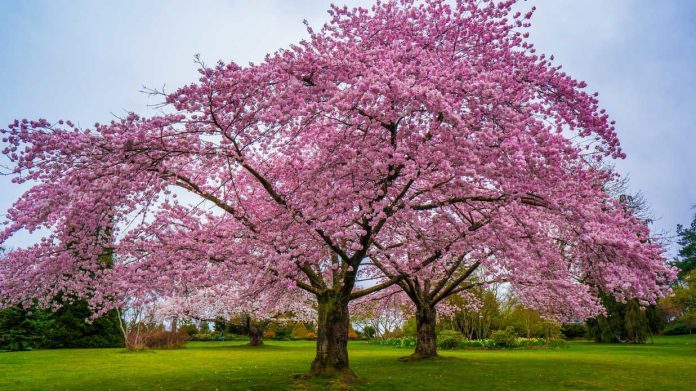Content Summary
A brief history of Hanami
Hanami, 花見 in Japanese, literally means “flower viewing.” People gather in mass to look at the trees and picnic (or even camp!) under the trees throughout Japan. The practice dates back centuries, with people first admiring plum blossoms instead (which bloom earlier than Sakura). This is called umemi, 梅見 in Japanese, “plum viewing”. But the first time Hanami specifically referred to the cherry blossom tree was in the world’s first novel, The Tale of Genji.
The Tale of Genji
The Tale of Genji, written in the early 11th century. Around this time, the Imperial Court began holding flower-viewing parties complete with feasting and drinking sake under the trees. Eventually, the lowly commoners were practicing Hanami as well, and a national pastime was born! And since Japan doesn’t have laws against having open containers of alcohol in public, nothing is stopping you from staying true to the traditional meaning of Hanami ? ? ?
Today, locations with a large number of trees often hold cherry blossom tree festivals, complete with souvenir booths, food stalls, and hordes of tourists.
Myths about Cherry Blossom Tress Season in Japan
There are a couple of basic “facts” often disseminated about cherry blossom tree in Japan for the uninitiated.
- It begins in mid-March.
- But it’s uncertain exactly when it will start (making planning difficult, if not futile).
- It lasts for one week, two at most.
- And then it’s gone. The trees disappear like ghosts in the wind.
All of these things are lies. Okay, “lies” is a bit harsh, but I can at least say that none of these things is a complete truth.
Luckily, the truth paints a much nicer picture for people who are trying to plan a trip to Japan to participate in Hanami!
5 things you need to know about Sakura in Japan
Japan is a much bigger country than you might expect. Its four main islands, Honshu, Hokkaido, Kyushu, and Shikoku, are together 150% of the United Kingdom’s size.
I traveled through ten locations on Honshu’s main island, ranging from Miyajima Island in the south to Hirosaki in the north. The drive between these places takes about eighteen hours.
From the coasts in the south to the Japanese alps — there were cherry blossoms in every single place! Even in places where the peak bloom was more than a month past. How is that even possible? I thought they bloom for a mere two weeks??
Here’s what I learned about the cherry blossom tree in Japan.
Every tree is different.
The phrase “late-bloomer” exists for a reason. Cherry blossom trees aren’t connected to each other by some underground communication network. Yes, most trees of a specific variety in a specific place do bloom together. However, it doesn’t mean that you’ll necessarily miss out on cherry trees in bloom because you’re too late. Many factors contribute to when a specific cherry tree blooms.
Left: Cherry trees in full bloom at Tenryu-Ji in Kyoto, 21. April (19 days after “full bloom” for the city). It’s most likely so late because it’s one of the common late-blooming varieties.
Sakura bloom depending on latitude
Sakura bloom over a broad time, largely based on latitude. For example, blooming begin in Okinawa as early as January. The “cherry blossom tree front” slowly moves north for several months, with Sakura blooming in Japan’s northern island, Hokkaido, throughout May. This front indicates the opening of the first blossoms, not the arrival of full bloom (often about a week or two after).
This means that any trip between February and May has the possibility of viewing cherry blossoms. That’s encouraging!
Sakura bloom depending on elevation
Latitude is not the only factor in creating the Spring conditions needed for cherry trees to bloom. A more southerly city can have a later cherry blossom tree season if it has a higher elevation (which keeps temperatures cooler).
For example, Tokyo was set to begin blooming around the 21st of March. Yet, at the beginning of May, we saw cherry blossom tree in full bloom in Kawaguchi-ko, a town southwest of Tokyo near Mt. Fuji. However, these trees were largely in full sun and included varieties that you’d expect to bloom at the beginning of the season.
Sakura bloom depending on immediate surroundings
Many cherry trees in bloom that I saw in the south of Honshu were in surroundings that either delayed or protected their blossoms. These trees were located in the shade or shielded from damaging Spring rains by other trees or buildings.
The flowers on the right bank have started to fall before those on the left. I would guess that the right bank is exposed to more powerful sunlight.
Cherry Blossom Tree depending on a variety
Different types of cherry trees bloom at other times. This is a large reason you can catch cherry trees throughout Japan during Spring after the first bloom.
Most of the pictures you’ll see of masses of blooming cherry trees are the Somei Yoshino variety, which blooms relatively early.
The oldest cherry blossom tree in Hirosaki Castle Park, a Somei Yoshino at 120 years old.
Are you enjoying this post? Make sure to continue reading this amazing blog about Cherry Blossom Tree and the fabulous trivia about it!
How to distinguish a cherry blossom tree!
Several factors can help distinguish the type of cherry blossom tree you’re viewing:
Look for: Number of petals.
They are typically characterized as having batches of 5, about 20, and about 100. The common Somei Yoshino has five petals.
Blossoms with fewer petals typically open earlier, whereas those with more than five petals open later by about two to four weeks. However, this partly explains why many of the cherry blossom trees we saw in the middle to the south of Japan’s main island were yaezakura, like the one pictured above.
A cherry tree on Kyoto’s Philosopher’s Path towards the end of April.
Look for: Shape of the Cherry Blossom tree.
Some trees are shaped like umbrellas, others are Y-shaped, others are the “weeping” variety, and some are even shaped like waterfalls.
Weeping trees are called Shidarezakura, literally, “Sakura with drooping boughs”. These trees have a long lifespan and, as a result, can become very large. They are categorized as either having five petals or having more than five petals.
Look for: Color of the blossoms.
If you’re like me, you’ve probably wondered why some cherry trees have white flowers, and some have pink. For some varieties, it is because their blossoms change color over the course of their flower-lives. But for the most part, many are merely differently colored from the start. Cherry blossom tree comes in white, yellow, even slightly light green and, of course, all imaginable shades of pink.
Right: カンヒザクラ Kanhizakura. This species of the cherry tree is native to Japan, Vietnam, and China. It’s most famously seen in Taiwan and Okinawa and other Ryukyu Islands of Japan. This variety blooms a bit later but still falls into the “early bloomer” batch.
Look for: Fresh leaves
Some trees only grow leaves after the blossoms have hit their peak, which is one of the reasons some trees look so full. Many cherry trees don’t have fresh green leaves, but rather red or copper fresh leaves.
駿河台匂, Surugadai nioi, has many dense fresh leaves, making this tree look relatively sparse in comparison with bushier cherry trees.
Look for: Time of blooming (relative to surrounding Cherry Blossom tree)
Different cherry trees can bloom over a month apart (and in extreme cases, even in different seasons!)
- Early bloomers: Kanzakura, Kawazuzakura, Kanhizakura
- Primary season bloomers: Somei Yoshino, Yamazakura
- Late bloomers: Shidarezakura (weeping cherry trees), Ichiyo, Ukon (yellow blossoms), Kanzan (common many-petaled blossoms)
- Late bloomers: Kikuzakura (as many as one hundred petals per blossom).
- A whole ‘nother season: Jugatsuzakura (literally, “October cherry”)
This cherry tree in Kyoto was about 20 days “overdue” for full bloom.









